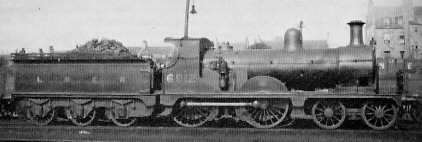The Manson D43 (GNSR Class P) 4-4-0 Locomotives

Manson's Class O (LNER D42) express locomotives of 1888 were proving successful, so it was natural that when the Great North of Scotland Railway (GNSR) required further express locomotives in August 1889, that the same basic design would be used. The new locomotives were fitted with a new, larger eight wheel tender. Six locomotives were ordered and all were delivered in 1890. Three were fitted with larger 6ft 6.5in driving wheels and became GNSR Class Q (LNER D38), but three retained the D42's small 6ft 0.5in driving wheels and became GNSR Class P (LNER D43). As such, the D43s were identical to the earlier D42s except for the larger tenders.
The new eight wheel tenders fitted to the D43s were fitted with a leading bogie and two rigid rear axles. At the time, these were the largest tenders in use on the GNSR and were designed specifically for through workings between Aberdeen and Elgin. Their 4 ton coal capacity was exceeded by some later GNSR tenders, but their 3000 gallon water capacity was never exceeded. All three D43s received Manson-designed six wheel tenders at or before Grouping (1923). No. 14 received a Johnson-designed six wheel tender in 1923.
No. 13 was re-boilered with a replacement saturated boiler in November 1916. A year later, Nos. 12 & 14 were rebuilt with superheated boilers. These superheated boilers used Robinson superheaters, and could be identified by their longer smokeboxes. Boiler swaps during LNER ownership led to both engines being fitted with saturated boilers identifiable by short smokeboxes. No. 12 (LNER No. 6812) ran with a saturated boiler from June 1932 until withdrawal. No. 14 (LNER No. 6814) was fitted with a saturated boiler from January 1928 to February 1931.
In common with their D38 brethren, the D43s were built with Ramsbottom safety valves with exposed columns and springs. The GNSR later fitted tall casings around the valves, and the LNER replaced them with Group Standard Ross pop safety valves. The Ross valves were mounted within the GNSR valve casings.
The GNSR allocated the D43s to Kittybrewster shed, and they were usually used on passenger trains between Aberdeen and Elgin. No. 13 was re-allocated to Elgin shortly before Grouping (1923). The LNER moved No. 13 (now No. 6813) back to Kittybrewster, and it was noted operating the Deeside line. No. 6812 was moved to Elgin, but No. 6814 stayed at Kittybrewster. All three were used on branch line duties before they were withdrawn between 1935 and 1938.
Technical Details
| Saturated | Superheated | ||
| Cylinders (x2): | (inside) | 18x26in. | 18x26in. |
| Motion: | Stephenson | Stephenson | |
| Valves: | slide | slide | |
| Boiler: | Max. Diameter: | 4ft 6in | 4ft 6in |
| Boiler: | Pressure: | 165psi | 160psi |
| Diagram No.: | 88 | 88 | |
| Heating Surface: | Total: | 1165 sq.ft. | 1000 sq.ft. |
| Firebox: | 106 sq.ft. | 106 sq.ft. | |
| Superheater: | 140 sq.ft. (18x1.1in) | ||
| Tubes: | 1059 sq.ft. (213x 1.75in) | 512 sq.ft. (104x 1.75in) | |
| Flues: | 242 sq.ft. (18x 4.75in) | ||
| Grate Area: | 18.2 sq.ft. | 18.2 sq.ft. | |
| Wheels: | Leading: | 3ft 9.5in | 3ft 9.5in |
| Coupled: | 6ft 0.5in | 6ft 0.5in | |
| Tender: | 4ft 1in | 4ft 1in | |
| Tractive Effort: | (@ 85% boiler pressure) | 16,296 lb | 15,802 lb |
| Wheelbase: | Total: | 42ft 10in | 42ft 10in |
| Engine: | 21ft 8in | 21ft 8in | |
| Tender: | 13ft 0in | 13ft 0in | |
| Weight (full): | Total: | 81 tons 8cwt | 83 tons 15cwt |
| Engine: | 44 tons 0cwt | 46 tons 7cwt | |
| Tender: | 37 tons 8cwt | 37 tons 8cwt | |
| Adhesive Weight: | 29 tons 16cwt | 31 tons 1cwt | |
| Max. Axle Load: | 15 tons 3cwt | 15 tons 18cwt |
Preservation
The last D43 was withdrawn in 1938, and none have survived into preservation.
Models
I am not aware of any models of the D43 in any scale.